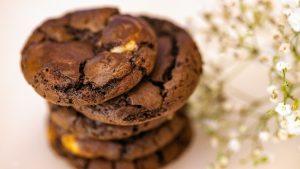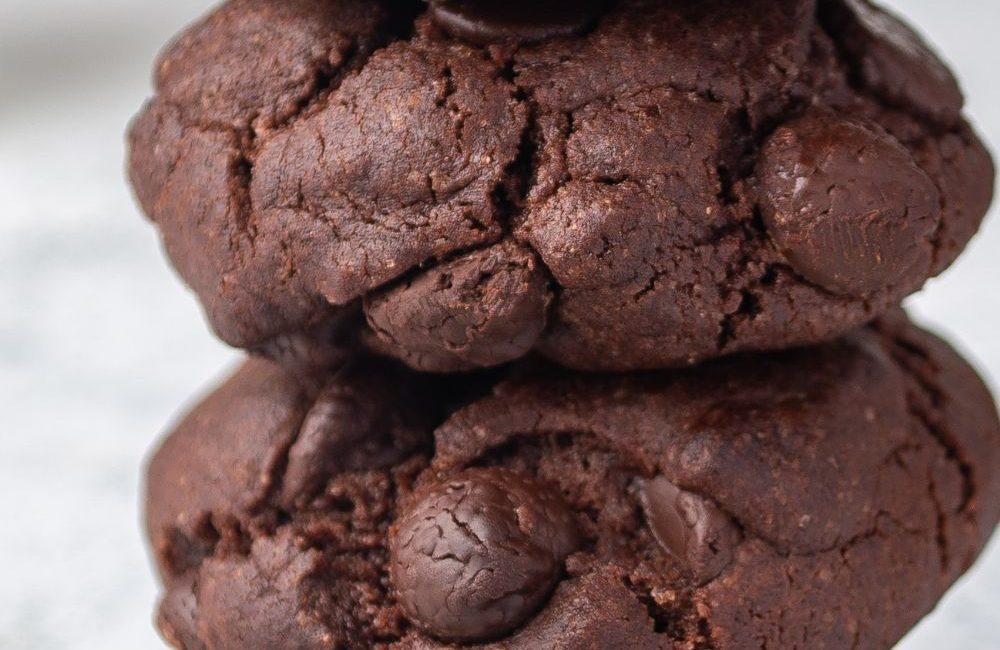Hey there, cookie enthusiasts! Have you ever found yourself eagerly pulling a batch of gluten-free cookies out of the oven, only to discover they turned out softer than expected? Don’t worry; you’re not alone.
In this blog post, we’ll dive into the world of gluten-free baking and unravel the mysteries behind those irresistibly soft cookies.
We’ll explore the key factors that contribute to their texture and share some handy tips to help you master the art of gluten-free cookie perfection.
So, grab a glass of milk and let’s get started on your journey to softer, chewier gluten-free delights!
The Mystery of Soft Gluten-Free Cookies Unveiled: Causes and Fixes.
There can be several reasons why your gluten-free cookies are soft after baking.
Gluten-free baking can be a bit tricky because the absence of gluten, a protein found in wheat, can affect the texture and structure of baked goods.
Here are some potential reasons for your soft gluten-free cookies:
Type of Flour: The type of gluten-free flour you use can greatly affect the texture of your cookies.
Some gluten-free flours, like rice flour or tapioca flour, tend to produce softer results.
Consider experimenting with a blend of different flours to achieve the desired texture.
A common gluten-free flour blend includes a mix of rice flour, tapioca starch, and potato starch.
Xanthan Gum or Guar Gum: Gluten provides elasticity and structure to baked goods, which gluten-free flours lack.
Adding a small amount of xanthan gum or guar gum to your gluten-free cookie recipe can help mimic the binding properties of gluten and improve the texture.
Liquid Ratio: The ratio of wet to dry ingredients in your recipe can impact the cookie’s texture.
Too much liquid or not enough dry ingredients can lead to cookies that are too soft. Make sure to follow the recipe’s measurements carefully.
Egg Substitute: If you’re using an egg substitute in your gluten-free cookies, it may not provide the same structure and moisture as real eggs.
Consider using a commercial egg replacer or experimenting with other binding agents like applesauce, mashed bananas, or flaxseed gel.
Overmixing: Overmixing the cookie dough can lead to a softer texture.
Unlike regular cookies where gluten development is desirable, gluten-free cookie dough should only be mixed until the ingredients are combined to avoid overmixing.
Baking Time and Temperature: Adjusting the baking time and temperature can also impact the texture.
Baking at a slightly higher temperature for a shorter time can help set the cookies and prevent them from being too soft.
Cooling Time: Allow your gluten-free cookies to cool completely on a wire rack. They may firm up as they cool.
Recipe Modifications: Consider searching for or creating gluten-free cookie recipes that are specifically designed to be soft.
Look for recipes that have received positive reviews from other gluten-free bakers.
Remember that achieving the perfect texture in gluten-free baking can take some trial and error.
You may need to experiment with different flours, binders, and techniques to find the right combination that gives you the softness you desire in your gluten-free cookies.

Further explanations: Exploring the reason why gluten-free cookies turn soft after baking.
Let’s delve deeper into these factors that can affect the texture of gluten-free cookies here:
1. Type of Flour:
The choice of gluten-free flour is crucial in determining the texture of your cookies. Different gluten-free flours have varying properties. For instance:
- Rice Flour: Rice flour tends to produce cookies with a softer and more delicate crumb. It’s often used in gluten-free baking for this reason.
- Tapioca Flour: Tapioca flour, also known as tapioca starch, adds a chewy texture to gluten-free cookies when used in combination with other flours. It helps create a pleasant mouthfeel.
- Potato Starch: Potato starch can contribute to a tender and slightly fluffy texture in gluten-free cookies. It’s often used in flour blends to enhance structure.
When creating a gluten-free flour blend, it’s common to combine these flours in specific ratios to achieve the desired texture. Experimenting with different flour combinations can help you find the perfect balance for your cookies.
2. Xanthan Gum or Guar Gum:
Gluten in traditional wheat flour provides elasticity and structure to baked goods. In gluten-free baking, you can use xanthan gum or guar gum to replicate these properties. Here’s how they work:
- Xanthan Gum: Xanthan gum is a common choice and is effective at improving the texture of gluten-free cookies. It acts as a binder, helping to hold the ingredients together and prevent cookies from becoming overly crumbly.
- Guar Gum: Guar gum can also be used as a binder and stabilizer in gluten-free baking, but it may have a slightly different texture-enhancing effect compared to xanthan gum.
Adding a small amount of xanthan gum or guar gum to your gluten-free cookie recipe can significantly enhance the cookies’ structure and prevent excessive softness.
3. Liquid Ratio:
Achieving the right balance of wet and dry ingredients is crucial in gluten-free cookie baking.
Too much liquid or too little dry ingredients can lead to excessively soft cookies. To ensure the correct texture:
- Follow the recipe’s measurements carefully.
- Consider factors like the moisture content of ingredients such as butter, eggs, or sweeteners.
- Adjust the amount of liquid if necessary to achieve the desired cookie dough consistency.
4. Egg Substitute:
If you’re baking gluten-free cookies without eggs or with egg substitutes, it’s essential to choose a suitable replacement to maintain structure and moisture:
- Commercial Egg Replacer: There are commercial egg replacers available that are specifically designed for baking. These products often provide good binding properties.
- Natural Binders: You can experiment with natural binding agents like applesauce, mashed bananas, or flaxseed gel. These can add moisture and help hold the cookie dough together.
The choice of egg substitute depends on your dietary preferences and any allergies or restrictions you may have.
By paying attention to these factors and making adjustments as needed, you can achieve gluten-free cookies with the desired softness and texture you’re aiming for in your baking endeavors.
5. Overmixing:
Overmixing the cookie dough, whether gluten-free or not, can lead to undesirable results.
In gluten-free baking, where you lack the gluten’s structural support, overmixing can be particularly problematic. Here’s why:
- Gluten Development: In traditional wheat-based cookie dough, gluten development is desirable because it gives cookies a chewy texture. However, in gluten-free baking, you want to avoid gluten development since there’s no gluten present. Overmixing can inadvertently develop unwanted structure in the dough, resulting in cookies that are tougher and less soft.
To prevent overmixing in gluten-free cookie dough, mix the ingredients only until they are just combined.
This ensures that the dough is properly mixed without risking excessive toughness.
6. Baking Time and Temperature:
Adjusting the baking time and temperature is a critical aspect of achieving the desired texture in gluten-free cookies:
- Temperature: Baking at a slightly higher temperature can help set the cookies’ structure more quickly, which can prevent excessive softness. However, be cautious not to use a temperature that’s too high, as it may lead to over-browning or uneven cooking.
- Baking Time: Reducing the baking time can also contribute to softer cookies. Keep a close eye on your cookies, and when they’re just starting to turn golden around the edges, they are often done. Gluten-free cookies may continue to set as they cool, so it’s better to slightly underbake them than overbake them.
Experimenting with temperature and baking time adjustments can help you fine-tune your recipe to achieve the perfect balance of softness and texture.
7. Cooling Time:
Allowing your gluten-free cookies to cool properly is an important step in achieving the desired texture:
- Firming Up: As gluten-free cookies cool on a wire rack, they often firm up. This is because the starches in the flours have a chance to set, providing structure to the cookies.
- Patience: It’s important to exercise patience and resist the urge to handle or taste the cookies immediately out of the oven. Let them cool completely to achieve the desired texture.
8. Recipe Modifications:
If you’re consistently experiencing issues with softness in your gluten-free cookies, consider making recipe modifications:
- Search for Specific Recipes: Look for gluten-free cookie recipes that are explicitly designed to be soft. These recipes often incorporate the right blend of flours, binders, and techniques to achieve the desired texture.
- User Reviews: Pay attention to user reviews and comments on recipe websites. Positive reviews from other gluten-free bakers can be a good indicator of a successful recipe.
- Experiment: Don’t hesitate to experiment with different recipes until you find the one that consistently produces the softness you’re looking for.
By taking these factors into account and making appropriate adjustments, you can improve the texture of your gluten-free cookies and create delicious treats that meet your expectations.
A complete tabular on this topic here.
Here’s a complete tabular summary of the factors that can make gluten-free cookies soft after baking:
| Factor | Explanation | Solution |
|---|---|---|
| Type of Flour | The choice of gluten-free flour affects texture. Some flours like rice flour and tapioca starch tend to produce softer cookies. | Experiment with different flour blends, e.g., rice flour, tapioca starch, and potato starch, to achieve desired texture. |
| Xanthan Gum or Guar Gum | Gluten provides structure; use xanthan gum or guar gum to mimic binding properties. | Add a small amount of xanthan gum or guar gum to the recipe for improved texture and structure. |
| Liquid Ratio | Incorrect balance of wet to dry ingredients can result in overly soft cookies. | Follow the recipe’s measurements accurately, consider moisture content, and adjust liquid as needed for the right dough consistency. |
| Egg Substitute | Replacing eggs with substitutes can impact structure and moisture content. | Choose suitable egg replacements such as commercial egg replacers or natural binders like applesauce, mashed bananas, or flaxseed gel. |
| Overmixing | Overmixing the dough can lead to unintentional structure development. | Mix the dough only until ingredients are combined to prevent excessive toughness. |
| Baking Time and Temperature | Adjusting baking time and temperature can influence cookie texture. | Bake at a slightly higher temperature for a shorter time to set cookies, and monitor for doneness carefully. Avoid over-baking. |
| Cooling Time | Proper cooling allows cookies to set and firm up. | Allow cookies to cool completely on a wire rack; they may firm up as they cool. |
| Recipe Modifications | Some recipes are specifically designed for soft gluten-free cookies. | Search for soft gluten-free cookie recipes or read user reviews to find successful recipes. Experiment with different recipes to achieve desired results. |
By addressing these factors and making appropriate adjustments in your gluten-free cookie baking process, you can achieve the desired level of softness and texture in your cookies.
My final words: Why are gluten-free cookies soft after baking?
Your gluten-free cookies may turn out soft after baking due to various factors, including the type of flour used, the presence or absence of binding agents like xanthan gum, the balance of wet and dry ingredients, the choice of egg substitutes, overmixing of the dough, baking time and temperature, insufficient cooling time, and the recipe itself.
Achieving the desired texture in gluten-free cookies requires careful consideration of these factors and making necessary adjustments to your baking process and recipe choices.

Whether you’re a passionate baker or simply seeking sweet inspiration, I’m here to provide you with valuable insights, mouthwatering recipes, expert tips, and more to make your cookie adventures with Mike truly delightful and scrumptious. You are on the true exciting cookie-filled side.




